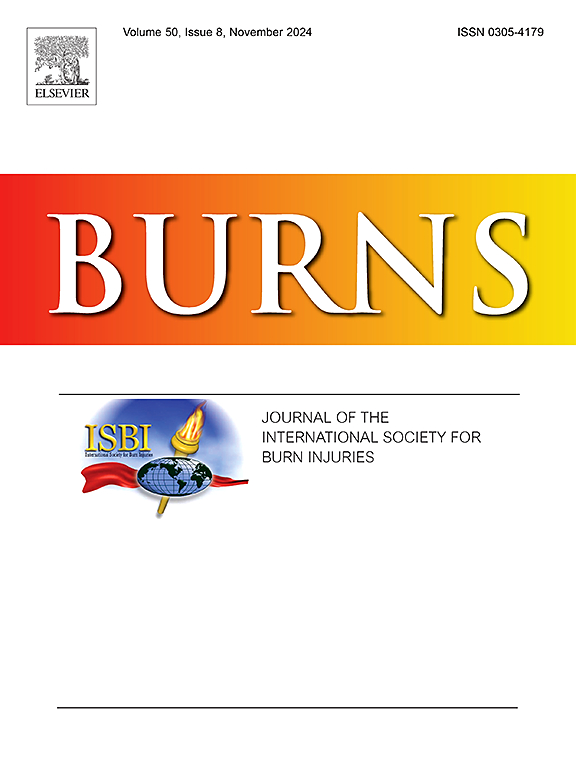Red propolis cream and its therapeutic potential for skin lesions caused by burns
IF 2.9
3区 医学
Q2 CRITICAL CARE MEDICINE
引用次数: 0
Abstract
Skin lesions, particularly burns, compromise the skin barrier and require effective treatment to accelerate healing and prevent infections. This study evaluated a topical formulation containing Olivem® 1000 and red propolis, which is rich in flavonoids, phenolic acids, and other bioactive compounds with antioxidant, antimicrobial, and anti-inflammatory properties. Stability tests confirmed that the formulation remained stable under high temperatures, with minimal changes in pH and viscosity, ensuring long-term effectiveness. The microbiological analysis demonstrated potent antimicrobial activity, with no microbial growth detected after 28 days against Staphylococcus aureus and Escherichia coli. In vitro assays on L929 cells revealed a concentration-dependent effect on viability, with cytotoxicity observed above 40 µg/mL (IC₅₀). The scratch assay demonstrated enhanced cell migration, indicating a positive effect on wound closure, while fluorescence microscopy confirmed increased cell proliferation and superoxide dismutase (SOD) levels, suggesting antioxidant protection. In addition, the formulation showed a marked reduction in the expression of pro-inflammatories, such as IL-6 and TNF-α. In vivo, treatment of second-degree burns in Wistar rats with Olivem®1000 and red propolis accelerated wound closure, reduced crust formation, and promoted more organized tissue compared to untreated controls. By day 21, nearly complete regeneration was observed, with a continuous epidermis and increased collagen deposition. Histological analysis revealed enhanced extracellular matrix organization. These findings underscore the formulation’s capacity to enhance tissue repair, improve wound quality, thereby suggesting its potential as a preclinical candidate for further studies in the domain of burn treatment.
红色蜂胶霜及其对烧伤引起的皮肤损伤的治疗潜力
皮肤损伤,特别是烧伤,损害皮肤屏障,需要有效治疗以加速愈合和预防感染。本研究评估了含有Olivem®1000和红蜂胶的局部配方,红蜂胶富含类黄酮、酚酸和其他具有抗氧化、抗菌和抗炎特性的生物活性化合物。稳定性测试证实,该配方在高温下保持稳定,pH值和粘度变化最小,确保长期有效。微生物学分析显示了有效的抗菌活性,对金黄色葡萄球菌和大肠杆菌28天后未检测到微生物生长。对L929细胞的体外测定显示对活力的浓度依赖性影响,观察到细胞毒性高于40 µg/mL (IC₅0)。划痕实验显示细胞迁移增强,表明对伤口愈合有积极作用,而荧光显微镜证实细胞增殖和超氧化物歧化酶(SOD)水平增加,表明抗氧化保护。此外,该制剂还能显著降低促炎因子如IL-6和TNF-α的表达。在体内,与未治疗的对照组相比,Olivem®1000和红色蜂胶治疗Wistar大鼠的二度烧伤加速了伤口愈合,减少了结痂的形成,并促进了更有组织的组织。到第21天,观察到几乎完全再生,表皮连续,胶原沉积增加。组织学分析显示细胞外基质组织增强。这些发现强调了该制剂增强组织修复,改善伤口质量的能力,从而表明其作为烧伤治疗领域进一步研究的临床前候选物的潜力。
本文章由计算机程序翻译,如有差异,请以英文原文为准。
求助全文
约1分钟内获得全文
求助全文
来源期刊

Burns
医学-皮肤病学
CiteScore
4.50
自引率
18.50%
发文量
304
审稿时长
72 days
期刊介绍:
Burns aims to foster the exchange of information among all engaged in preventing and treating the effects of burns. The journal focuses on clinical, scientific and social aspects of these injuries and covers the prevention of the injury, the epidemiology of such injuries and all aspects of treatment including development of new techniques and technologies and verification of existing ones. Regular features include clinical and scientific papers, state of the art reviews and descriptions of burn-care in practice.
Topics covered by Burns include: the effects of smoke on man and animals, their tissues and cells; the responses to and treatment of patients and animals with chemical injuries to the skin; the biological and clinical effects of cold injuries; surgical techniques which are, or may be relevant to the treatment of burned patients during the acute or reconstructive phase following injury; well controlled laboratory studies of the effectiveness of anti-microbial agents on infection and new materials on scarring and healing; inflammatory responses to injury, effectiveness of related agents and other compounds used to modify the physiological and cellular responses to the injury; experimental studies of burns and the outcome of burn wound healing; regenerative medicine concerning the skin.
 求助内容:
求助内容: 应助结果提醒方式:
应助结果提醒方式:


